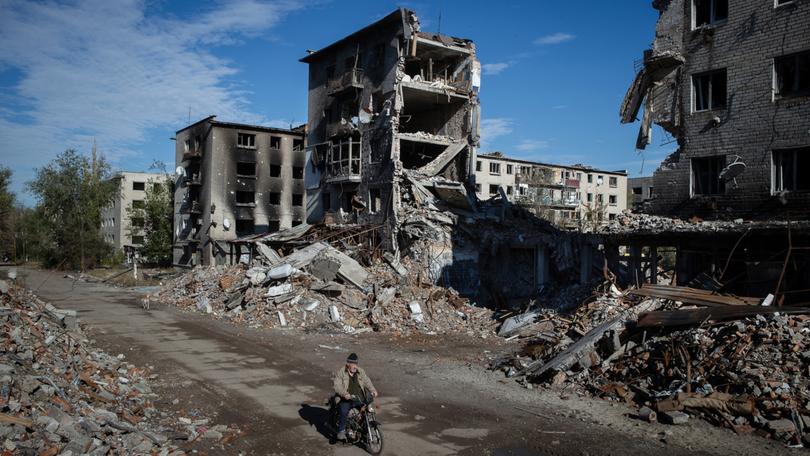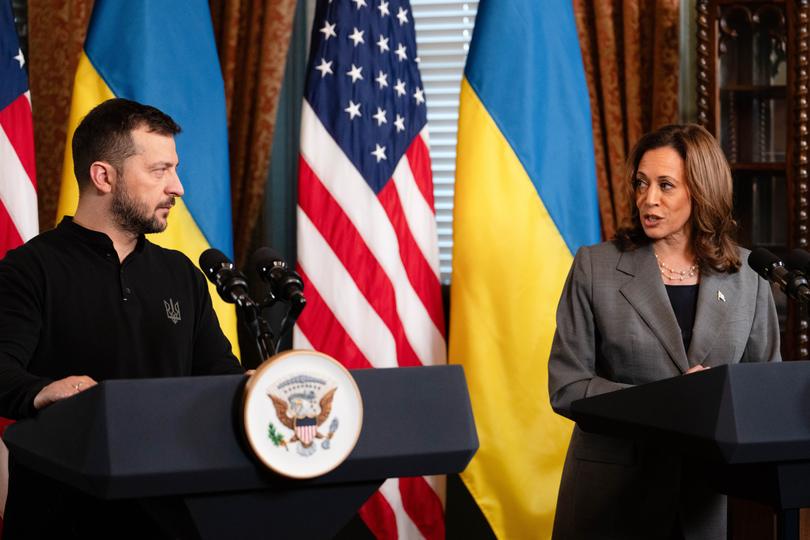THE NEW YORK TIMES: With limited options, President Volodymyr Zelenskyy seeks a path forward for Ukraine

KYIV, Ukraine — For weeks, President Volodymyr Zelenskyy of Ukraine has pushed Western leaders to support his so-called victory plan, which he claims will end the country’s war with Russia next year. But Zelenskyy has received only lukewarm rhetorical support.
No country has agreed to allow Ukraine to fire Western long-range missiles at military targets deep inside Russia. Nor has any major power publicly endorsed inviting Ukraine into NATO while the war is raging.
By those measures, Zelenskyy’s lobbying tour of the United States and Europe over the past six weeks could be seen as a failure.
Sign up to The Nightly's newsletters.
Get the first look at the digital newspaper, curated daily stories and breaking headlines delivered to your inbox.
By continuing you agree to our Terms and Privacy Policy.But the real audience for the plan might be at home, some military analysts and diplomats say. Zelenskyy can use his hard sell — including a recent address to Parliament — to show Ukrainians that he has done all he can, prepare them for the possibility that Ukraine might have to make a deal and give Ukrainians a convenient scapegoat: the West.
With waning Western support, losses along the eastern front and in the Kursk region of Russia, and a looming U.S. election that could mean a drastically different policy toward Ukraine, Zelenskyy might have few other options.
“He has to go cap in hand to push the plan, sort of carve out a position and then say at home, having asked, that this is now what we have to do,” said Michael John Williams, a professor of international relations at Syracuse University and a former adviser to the North Atlantic Treaty Organization. He added: “At least he can say he’s tried. He’s exhausted the possibilities.”
Zelenskyy is doing whatever possible to get the United States and other allies to commit to what Ukraine believes it needs, so he can negotiate from a position of strength. The Ukrainian president is using the arrival of North Korean troops to fight alongside the Russians in Kursk — confirmed by the head of NATO on Monday — to try to build some momentum for his plan.
In an interview session with reporters last week, Zelenskyy said that there was no evident Plan B if the West didn’t support his plan.
“I’m not insisting that they do it exactly this way,” Zelenskyy said. “I said it will work. If you have an alternative, then please, go ahead.”
He reiterated that he was still against ceding territory. But he also talked about diplomatic steps to resolve issues like protecting energy infrastructure and establishing a safe shipping corridor out of Ukraine on the Black Sea.

And he hinted at one approach that might allow Ukraine to save face if it does not reclaim all the land Russia has captured. “No one will legally recognise the occupied territories as belonging to other states,” he said.
U.S. officials have privately expressed some exasperation with Zelenskyy’s victory plan, calling it unrealistic and dependent almost entirely on Western aid. They spoke on condition of anonymity to discuss sensitive military information.
Case in point: In one part not made public, Zelenskyy proposed a “non-nuclear deterrence package” in which Ukraine would get Tomahawk missiles, a totally unfeasible request, a senior U.S. official said. A Tomahawk has a range of 1,500 miles, more than seven times the range of the long-range missile systems called ATACMS that Ukraine got this year. And the United States sent only a limited number of those, senior U.S. officials said.
Ukraine also hadn’t made a convincing case to Washington on how it would use the long-range weapons, the U.S. officials said. The target list inside Russia far exceeded the number of missiles that the United States or any other ally could supply without jeopardizing missiles earmarked for potential problems in the Middle East and Asia, they added.
Four U.S. officials told The New York Times recently that Zelenskyy was stunned that President Joe Biden didn’t grant him permission to use U.S. long-range missiles to strike deep inside Russia when they met in Washington in September. In the past, Biden had usually relented after initially refusing Ukraine’s requests for weapons like Abrams tanks, F-16 fighter jets and ATACMS.
Zelenskyy’s office confirmed that he had been stunned. Dmytro Lytvyn, an adviser to Zelenskyy, said Ukraine had explained repeatedly why it needed to use long-range missiles. “All the details, the list of targets and the arguments are with the Americans,” he said. “Unfortunately, there is still no political decision to proceed.”
As Zelenskyy continues to push his plan, the war is extracting deep tolls on both sides. Russia is grinding forward in the east. Ukrainian soldiers, many of whom enlisted after the Russians invaded in February 2022, are exhausted. Not enough new soldiers are signing up. Those who do are often older and poorly trained.
But Russia is suffering steep casualties in its grim march forward; it lost more soldiers to death and injuries in September than any other month of the war, American officials said; U.S. and British military analysts put the toll at more than 1,200 a day.
There is widespread agreement that neither side is ready for formal negotiations. Russian President Vladimir Putin has claimed repeatedly that he’s ready for talks, including last week, when he said, “the ball is in their court,” referring to Ukraine. But two former Russian officials who remain close to the Kremlin said they didn’t believe Putin would in fact negotiate so long as Ukrainian forces are in Kursk.
After Russia hosted Turkey and about 30 other countries in the city of Kazan, Putin told state television that President Recep Tayyip Erdogan of Turkey had delivered a new proposal aimed at starting negotiations with Ukraine over navigation in the Black Sea “and some other matters.”
Putin claimed Ukraine had previously made negotiation proposals through Turkey but then declined to engage; he said it was “impossible to make plans on this basis.” Ukrainian and Western officials view Russia’s offers to discuss peace as a demand for capitulation.
In fact, Zelenskyy has pleaded with the United Nations to support Ukraine and to prevent Russia from freezing the war.
With polls showing that most Ukrainians still do not favour giving up land, Zelenskyy is trying to balance political pressures at home and a changing landscape abroad.
The threat of a widespread conflict in the Middle East has shifted attention from Ukraine. Western fatigue with the war in Ukraine is real, “and increasingly so,” the foreign minister of Finland told the Financial Times recently.
The president of the Czech Republic said last month that Ukraine needed to face the reality that it will have to temporarily cede territory to Russia. Many diplomats and analysts say the most likely outcome in the near future for the war is a deal that would temporarily freeze the two sides along a yet-to-be-determined line. But Putin would have to be convinced that he could gain no more territory if any cease-fire is going to last.
“More and more we hear in Washington and Europe that Kyiv is unreasonable to expect to regain 100% of its territory, and the Ukrainians are beginning to get their heads around it,” said Camille Grand, a former NATO assistant secretary-general and defence expert at the European Council on Foreign Relations who just visited Ukraine.
“There is a world where they concede Russian occupation for some time,” he said. But there would need to be demilitarization of the front line and “then Ukrainians want super security guarantees to avoid a Russian resurgence of the war in five years.”
The U.S. election, just days away, will go a long way toward determining the war’s future, analysts say.
Former President Donald Trump, the Republican candidate, and his running mate, Sen. JD Vance, have made clear their scepticism about continuing American support for Ukraine. Vice President Kamala Harris, the Democratic candidate, has said she will continue Biden’s support for Ukraine, but many experts say that she might recalibrate what aid the United States is willing to deliver.
And then there is Zelenskyy’s top goal — to win an invitation to NATO during the war. While some NATO allies, like the Baltic nations and Poland, seem open to the idea and NATO has promised repeatedly that Ukraine will eventually join the alliance, the United States and Germany oppose inviting Ukraine during the war because of fears NATO could be drawn into a conflict with nuclear-armed Russia.
The Ukrainians may be hoping that Biden will do something after the election to burnish his legacy on Ukraine — possibly approving the use of long-range missiles, for example, or a faster track into NATO.
Among Ukrainians, blaming the West — rare in the first year of the war — is gaining traction after delays in military aid and a feeling that Ukraine’s allies are only providing enough weapons for Ukraine not to lose. Europe and the United States have so far spent about $220 billion on aid and military equipment for Ukraine, according to the Kiel Institute for the World Economy in Germany.
At the battlefront, the frustration with the United States and its allies is palpable. A drone pilot in the 57th Brigade in Ukraine, who goes by the call sign Fregat, said in an interview that he wanted the current front line to be frozen because the Ukrainians couldn’t beat the Russians with just shovels and machine guns. He blamed the Europeans and America for not providing more high-precision weapons.
A volunteer helping to evacuate people near Pokrovsk, an eastern town that Russian troops are closing in on, said the West just wanted to weaken Russia, not help Ukraine win.
“Soon, there may be no one left even to use the weapons they give us,” said the volunteer, Yevhen Tuzov, “because all our Western partners want is for us to fight until the last Ukrainian.”
This article originally appeared in The New York Times.
© 2024 The New York Times Company
Originally published on The New York Times
